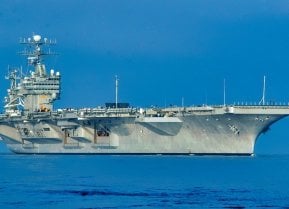Russia's Borei-Class Submarines Run Silent and Could Kill Millions
While the Borei-Class was designed to replace the preceding Russian SSBN Typhoon-class, the Borei-Class is notably smaller than its predecessors.
The first submarine Russia developed after the fall of the Soviet Union was the Project 955 Borei. Known to NATO as the Dolgorukiy, the Borei-Class is a fourth-generation nuclear-powered ballistic missile submarine (SSBN). While the Borei was designed to replace the preceding Russian SSBN Typhoon-class, the Borei-Class is notably smaller than its predecessors. Whereas the Typhoon has a volume of 48,000 tons and requires 160 crewmen to operate, the Borei has a volume of just 24,000 tons and needs just 107 crewmen to operate.
The Origins Of The Program
Initial design work for the program began in the 1980s, although the fall of the Soviet Union would interrupt progress; construction on the first vessel would not begin until 1996.
The program was first known as Project 935, but “was changed to Project 955, and the submarine was redesigned to accommodate the new submarine-launched ballistic missile (SLBM) Bulava (SS-NX-30) in place of the abandoned R-39UTTH Bark missile,” according to Naval Technology.
Rubin Design Bureau designed (naturally) the Borei, which was built in the Sevmash shipyard in the northern port of Severodvinsk.
The first vessel in the Borei-class, the Yury Dolgorukiy, was scheduled for launch in 2002 – but budget constraints delayed the program. The Yury Dolgorukiy would not leave its construction hall until 2007, when, on April 15th, the Russians held a ceremony for their first strategic missile submarine launch in seventeen years.
The Borei’s Design
The Borei-Class was designed with a hydrodynamically efficient hull for the sake of reducing broadband noise. The hull design is compact and is significantly smaller than the Typhoon-class SSBN. Notably, the Borei features a pump-jet propulsion, marking the first time a Russian nuclear submarine has used a pump-jet propulsion.
A pump-jet does have some advantages over bare propellers. For example, a pump-jet allows for higher speeds before cavitation occurs (because of the raised internal dynamic pressure); pump-jets create high power density; improved shallow water performance; increased maneuverability; and noise reduction. While the Borei is the first Russian submarine to incorporate pump-jets, other navies have already incorporated the technology; submarines that also use pump-jets include the Royal Navy’s Trafalgar and Astute-class; the U.S. Navy Seawolf and Virginia-class; and the French Navy’s Triomphant and Barracuda-class.
Propelling the Borei’s pump jet is an OK-650 nuclear reactor.
The Russians have boasted that the Borei has a five times lower noise signature compared to their third-generation Akula-class submarine and two times lower when compared to the U.S. Virginia-class submarine. While the Russians may be overexaggerating the stealth quality of the Borei, observers agree that the Borei is stealthier than preceding Russian SSBNs. Although, reports indicate that the Borei’s hydraulic pumps tend to grow louder as they operate, increasing the submarine’s noise signature, and reducing the submarine’s stealth qualities.
The Borei-Class Specifications
The Borei-class measures 560 feet long, with a 43-foot diameter. When submerged, the Borei can achieve speeds of 25 knots or more. The submarine is outfitted with a floating rescue chamber, which is sufficient to accommodate the entire crew.
Despite being relatively short and compact, the Borei can carry 16 missiles (new and improved Borei may be able to carry as many as 20 missiles) because the Bulava SLBM is smaller than the R-39UTTH.
“The Bulava SLBM (designated RSM-56 in the START treaty), which is based on the Topol M design, is being fitted onto the Borei Class submarines,” according to Naval Technology. “These missiles were developed by the Moscow Institute of Thermal Technology and were launched on the Project 955 platform.”
The Bulava measures 12.1 meters long, with a diameter of 2.1 meters. The Bulava missiles weigh 36.8 tons and can house between six and ten re-entry vehicles, each with a yield of 100k-150k.
The Borei also carries six SS-N-15 missiles. The SS-N-15 is a 533mm anti-ship missile with a range of 45 kilometers. The SS-N-15 can be fitted onto either a 20k warhead or a type 40 torpedo.
In all, the Borei is a complex machine; each Borei is built with 1.3 million components and mechanisms and requires 17,000 tons of metal – which is about 50 percent more metal than was used to construct the Eiffel Tower. Throughout the Borei, 109 kilometers of piping was used, while 600 kilometers of wiring was used. The hull of the boat is covered in ten thousand rubber plates. Indeed, the Borei is a complex machine.
To date, seven Borei-class submarines have been commissioned.
Looking Ahead
While the Borei is still a relatively new addition to the Russian armed forces, a planned successor has already been revealed: the Arcturus-class SSBN. The Rubin Design Bureau, designers of the Borei, will also lead the design of the Arcturus, which will feature an angled hull to make the submarine harder to detect.
About the Author
Harrison Kass is a prolific defense and national security writer with over 1,000 articles published. An attorney, pilot, guitarist, and minor pro hockey player, Harrison joined the US Air Force as a Pilot Trainee but was medically discharged. Harrison holds a BA from Lake Forest College, a JD from the University of Oregon, and an MA from New York University. Harrison listens to Dokken.


